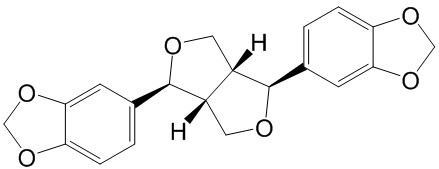Home
Products
Sesamol



| Product Name | Sesamol |
| Price: | $15 / 20mg |
| Catalog No.: | CN03913 |
| CAS No.: | 533-31-3 |
| Molecular Formula: | C7H6O3 |
| Molecular Weight: | 138.12 g/mol |
| Purity: | >=98% |
| Type of Compound: | Phenols |
| Physical Desc.: | Cryst. |
| Source: | The seeds of Sesamum indicum. |
| Solvent: | Chloroform, Dichloromethane, Ethyl Acetate, DMSO, Acetone, etc. |
| SMILES: | Oc1ccc2c(c1)OCO2 |
| Contact us | |
|---|---|
| First Name: | |
| Last Name: | |
| E-mail: | |
| Question: | |
| Description | Sesamol is a constituent of sesame oil. Sesamol shows a free radical scavenging activity. Sesamol shows an IC50=5.95±0.56 μg/mL in the DPPH assay. Anti-oxidant activities[1]. Anticancer activities[2]. |
| In Vitro | Sesamol has also been shown to be a classical inhibitor of lipid peroxidation[1]. Sesamol (0-1 mM) efficiently induces the apoptosis of human liver hepatocellular carcinoma (HepG2) cells. Sesamol suppresses cell proliferation and induces intrinsic and extrinsic apoptosis in HepG2 cells. Sesamol treatment elicites mitochondrial dysfunction by inducing a loss of mitochondrial membrane potential. Sesamol inhibits mitophagy and autophagy through impeding the PI3K Class III/Belin-1 pathway. Sesamol decreases the expression of anti-apoptotic protein Bcl-2, but shows no effect on the expression of apoptotic signal Bax. Sesamol improves the protein expression of Fas/FasL, and activates tBid and caspase-8 which are all involved in the extrinsic apoptosis pathway[2]. |
| In Vivo | Sesamol treatment for 35 days does not significantly impact body weight, although the tumor volume is dramatically inhibited (40.56% size inhibitory rate with Sesamol at 200 mg/kg compared to the control group). However, a lower dose (100 mg/kg Sesamol) only has significant anti-tumor growth effect up to 27 days after the first treatment. The Bcl-2/Bax ratio in tumor tissues is also decreased. Moreover, in the Sesamol treatment group, levels of the cell proliferation marker Ki76 are down-regulated, and levels of the cell apoptosis marker cleaved-caspase 3 are increased when compared to control. The expression of LC3 protein is remarkably decreased by Sesamol in a dose-dependent manner[2] |
| Density | 1.4±0.1 g/cm3 |
| Boiling Point | 274.0±29.0 °C at 760 mmHg |
| Flash Point | 119.5±24.3 °C |
| Exact Mass | 138.031693 |
| PSA | 38.69000 |
| LogP | 1.52 |
| Vapour Pressure | 0.0±0.6 mmHg at 25°C |
| Storage condition | −20°C |